Related Research Articles

Prednisolone is a steroid medication used to treat certain types of allergies, inflammatory conditions, autoimmune disorders, and cancers. Some of these conditions include adrenocortical insufficiency, high blood calcium, rheumatoid arthritis, dermatitis, eye inflammation, asthma, and multiple sclerosis. It can be taken by mouth, injected into a vein, used topically as a skin cream, or as eye drops.
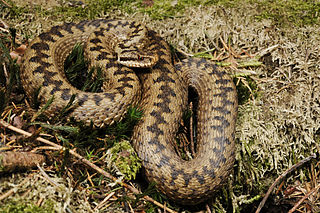
Vipera berus, the common European adder or common European viper, is a venomous snake that is extremely widespread and can be found throughout most of central and eastern Europe and as far as East Asia.

Amoxicillin/clavulanic acid, also known as co-amoxiclav or amox-clav, sold under the brand name Augmentin, among others, is an antibiotic medication used for the treatment of a number of bacterial infections. It is a combination consisting of amoxicillin, a β-lactam antibiotic, and potassium clavulanate, a β-lactamase inhibitor. It is specifically used for otitis media, streptococcal pharyngitis, pneumonia, cellulitis, urinary tract infections, and animal bites. It is taken by mouth or by injection into a vein.

The boomslang is a large, highly venomous snake in the family Colubridae.

The Gaboon viper, also called the Gaboon adder, is a viper species found in the rainforests and savannas of sub-Saharan Africa. Like all other vipers, it is venomous. It is the largest member of the genus Bitis, and it has the longest fangs of any venomous snake – up to 2 inches (5 cm) in length – and the highest venom yield of any snake. No subspecies are recognized.

Russell's viper, is a venomous snake in the family Viperidae native to the Indian subcontinent and one of the big four snakes in India. It was described in 1797 by George Shaw and Frederick Polydore Nodder, and named after Patrick Russell, who wrote about it in his 1796 work An account of Indian serpents, collected on the coast of Coromandel.

Tiger snakes are a large and highly venomous snake of southern Australia, including its coastal islands and Tasmania. These snakes are often observed and locally well known by their banding, black and yellow like a tiger, although the species can be highly variable in coloration and patterning. All populations are classified within the genus Notechis (Elapidae). Their diverse characteristics have been classified either as distinct species or by subspecies and regional variation.

The inland taipan, also commonly known as the western taipan, the small-scaled snake or the fierce snake, is a species of extremely venomous snake in the family Elapidae. The species is endemic to semi-arid regions of central east Australia. Aboriginal Australians living in those regions named the snake dandarabilla. It was formally described by Frederick McCoy in 1879 and then by William John Macleay in 1882, but for the next 90 years it was a mystery to the scientific community; no further specimens were found, and virtually nothing was added to the knowledge of this species until its rediscovery in 1972.

The common krait, also known as Bengal krait, is a species of highly venomous elapid snake of the genus Bungarus native to the Indian subcontinent. It is a member of the "Big Four" species that inflict the most snakebites on humans in Pakistan, India and Bangladesh.

The banded krait is a species of elapid snake found on the Indian Subcontinent, in Southeast Asia, and in southern China. It is the largest species of krait, with a maximum length up to 2.7 m.
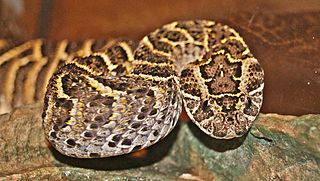
The puff adder is a viper species found in savannahs and grasslands from Morocco and western Arabia throughout Africa except for the Sahara and rainforest regions. It is responsible for causing the most snakebite fatalities in Africa owing to various factors, such as its wide distribution, frequent occurrence in highly populated regions, and aggressive disposition. Like all other vipers, it is venomous. Two subspecies are currently recognized, including the nominate subspecies described here.
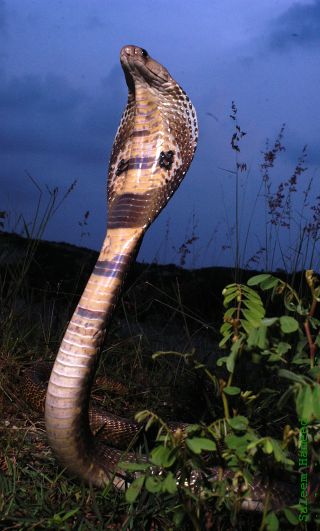
The Indian cobra, also known as the spectacled cobra, Asian cobra, or binocellate cobra, is a species of cobra found in India, Pakistan, Bangladesh, Sri Lanka, Nepal, and Bhutan, and a member of the "big four" species that are responsible for the most snakebite cases in India.

Enhydrina schistosa, commonly known as the beaked sea snake, hook-nosed sea snake, common sea snake, or the Valakadeyan sea snake, is a highly venomous species of sea snake common throughout the tropical Indo-Pacific. This species is implicated in more than 50% of all bites caused by sea snakes, as well as the majority of envenomings and fatalities.
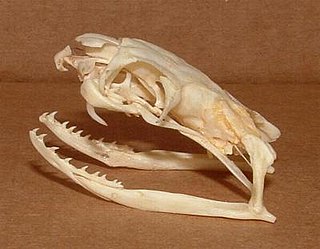
Venomous snakes are species of the suborder Serpentes that are capable of producing venom, which they use for killing prey, for defense, and to assist with digestion of their prey. The venom is typically delivered by injection using hollow or grooved fangs, although some venomous snakes lack well-developed fangs. Common venomous snakes include the families Elapidae, Viperidae, Atractaspididae, and some of the Colubridae. The toxicity of venom is mainly indicated by murine LD50, while multiple factors are considered to judge the potential danger to humans. Other important factors for risk assessment include the likelihood that a snake will bite, the quantity of venom delivered with the bite, the efficiency of the delivery mechanism, and the location of a bite on the body of the victim. Snake venom may have both neurotoxic and hemotoxic properties. There are about 600 venomous snake species in the world.

Echis is a genus of vipers found in the dry regions of Africa, the Middle East, India, Sri Lanka and Pakistan. They have a characteristic threat display, rubbing sections of their body together to produce a "sizzling" warning sound. The name Echis is the Latin transliteration of the Greek word for "viper" (ἔχις). Like all vipers, they are venomous. Their common name is "saw-scaled vipers" and they include some of the species responsible for causing the most snakebite cases and deaths in the world. Twelve species are currently recognized.

Naja is a genus of venomous elapid snakes commonly known as cobras. Members of the genus Naja are the most widespread and the most widely recognized as "true" cobras. Various species occur in regions throughout Africa, Southwest Asia, South Asia, and Southeast Asia. Several other elapid species are also called "cobras", such as the king cobra and the rinkhals, but neither are true cobras, in that they do not belong to the genus Naja, but instead each belong to monotypic genera Hemachatus and Ophiophagus.

The king brown snake is a species of highly venomous snake of the family Elapidae, native to northern, western, and Central Australia. Despite its common name, it is a member of the genus Pseudechis and only distantly related to true brown snakes. Its alternative common name is the mulga snake, although it lives in many habitats apart from mulga. First described by English zoologist John Edward Gray in 1842, it is a robust snake up to 3.3 m (11 ft) long. It is variable in appearance, with individuals from northern Australia having tan upper parts, while those from southern Australia are dark brown to blackish. Sometimes, it is seen in a reddish-green texture. The dorsal scales are two-toned, sometimes giving the snake a patterned appearance. Its underside is cream or white, often with orange splotches. The species is oviparous. The snake is considered to be a least-concern species according to the International Union for Conservation of Nature, though may have declined with the spread of the cane toad.
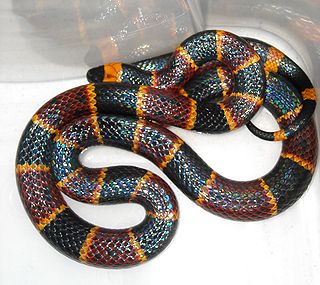
Micrurus fulvius, commonly known as the eastern coral snake, common coral snake, American cobra, and more, is a species of highly venomous coral snake in the family Elapidae. The species is endemic to the southeastern United States. It should not be confused with the scarlet snake or scarlet kingsnake, which are harmless mimics. No subspecies are currently recognized.

Isothipendyl is a 1st generation H1 antagonist (antihistamine) and anticholinergic used as an antipruritic. It is nowadays scarcely used in the 1st line relief of allergies due to the anticholinergic side effect of somnolence but does have some limited use through topical application in the relief of insect bites and related itching (pruritus).